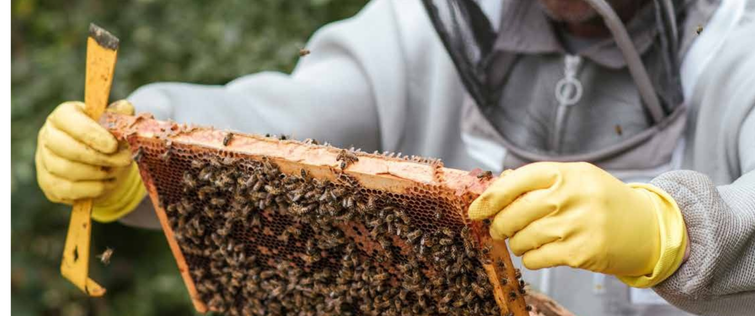New Zealand is on a mission to eliminate a deadly bee disease impacting 10,000+ beekeepers. A new mobile platform, HiveHub, is transforming the process of monitoring and compliance across the industry. The early results are in and they are, dare we say, buzzing.
The Management Agency (TMA) is a not-for-profit, levy-funded organisation responsible for managing the industry’s goal to eliminate American foulbrood (AFB) disease from New Zealand’s beekeeping industry. They educate beekeepers on methods to eliminate AFB from their colonies, monitor strict Government regulations, and help beekeepers comply with their reporting obligations including their Annual Disease Returns (ADR). Clifton King, National Compliance Manager, runs TMA’s lean team of staff and inspectors.

“With 10,000+ beekeepers all over the country, registering apiaries, colonies, locations, compliance, levies, contacts and communications is a huge task. We knew that the right technology could automate a lot of manual processes and be more efficient for everyone.”
Having set up their legacy IT platform well over a decade ago, it was showing its age. Disconnected financial and membership systems meant a lot of paper-based processes and double-entry. A clunky user interface made self-service tools complex, which led to errors and increased support. Overall, usage rates of the digital system were low, compliance was impacted and up to 30% of members found it easier to complete their reporting on paper.
TMA’s largest digital transformation project in decades
Embarking on such a major project, TMA was pleasantly surprised to see that cloud-based software made the upfront and management costs much lower than previous on-premise infrastructure.
TMA conducted a comprehensive request for proposal process before shortlisting four potential partners. King explains why Seisma stood out from the pack:
“It was clear in Seisma’s proposal and demo that they’d listened deeply to our needs and genuinely cared about our business outcomes. Rather than just quote to build what we’d asked for, they took the time to work with us to define what we needed and consult with us on how to get there.”
Before touching any software, the first step involved business analysis, mapping processes and re-engineering workflows – including financial integrations - to determine precisely what was needed. As a levy-funded not-for-profit, TMA needs to squeeze the most value out of every dollar, explained King.
"When Salesforce offered to come to the party with favourable not-for-profit pricing, this put world-class functionality within reach of our tight budget. It sealed the deal.”
“Win, win, win!” for beekeepers, inspectors and the industry
HiveHub’s core functionality for managing beekeeper records, communications and support came pre-built into the Salesforce platform.
The core Salesforce platform manages apiary registrations, disease notifications, ADR notifications, inspection certificates and member support, while Salesforce Experience Cloud enables beekeepers and inspectors to manage their own accounts.
However, TMA also had some specific customisation requirements:
- With many users working in remote areas with patchy mobile coverage at best, HiveHub had to function offline. Seisma developed a customised iOS/Android app that would work offline and synchronise when re-connected.
- HiveHub was also integrated with Google’s geospatial validation service which enabled specific apiaries to be pinpointed and logged in the system at a push of a button.
- Finally, it was integrated with MYOB and New Zealand’s post address validation service, to keep all member details up-to-date and synchronised – a significant shortfall with TMA’s legacy software.
The numbers speak for themselves
By integrating financial (MYOB) and member management systems, with a user-friendly mobile app, HiveHub has delivered fully-automated processes for levy invoicing, ADR submissions, email reminders, member support and communications.
Step-by-step self-service features for beekeepers and inspectors makes it easy to comply with regulations and streamlines the process for users and the TMA team.
“Beekeepers can be a tough crowd! So the amount of positive feedback we’ve had about HiveHub has been phenomenal. The usage and compliance data backs this up,“ said King.
- 4% increase in beekeepers submitting their Annual Disease Return (ADR) on time.
- 94% electronic submission of beekeeper ADRs rather than on paper (up from 70%).
- Significant decrease in late payments, penalty notices and chasing up levies improves cashflow.
The best is yet to come
While off to a strong start, King believes they have only just scratched the surface.
“Longer term, having an integrated platform like Salesforce gives us real- time reporting dashboards across the industry. Even with people spread across the country, we have visibility over beekeeper compliance, inspector activity and industry and seasonal trends.”
“This data helps us make informed decisions on new services to help beekeepers tackle AFB, and improves transparency to the board. I would absolutely recommend this solution to member organisations.”
To further connect the industry, there is potential to add an API gateway to allow third-party commercial apiary management platforms to integrate directly with HiveHub.
The bottom line: New Zealand’s beekeeping industry is now better equipped than ever to work towards eliminating AFB disease today, and into the future.
*This case study is sourced from acquired company Smartapps.